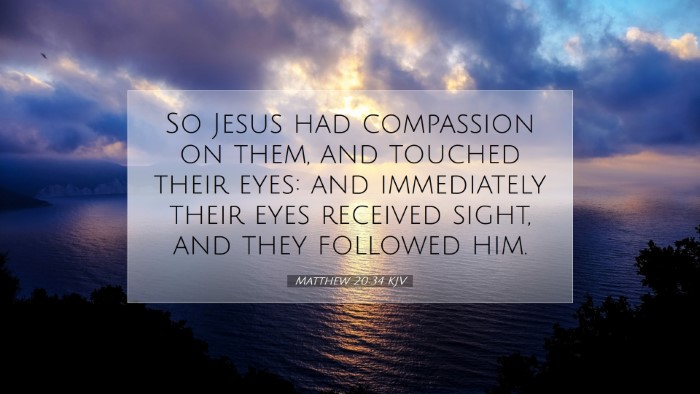Commentary on Matthew 20:34
Text of Matthew 20:34 (KJV): "So Jesus had compassion on them, and touched their eyes: and immediately their eyes received sight, and they followed him."
Introduction
This verse captures a powerful moment in the ministry of Jesus, showcasing His compassion and divine authority. In the context of the surrounding narrative, it emphasizes the themes of faith, healing, and the transformative power of Christ's touch.
Contextual Overview
Matthew 20 narrates the events leading up to Jesus’ final journey to Jerusalem, including His teaching on servanthood and a miraculous healing. The events positioned before verse 34 illustrate several groups’ responses to Christ, setting the stage for the interaction with the blind men.
Compassion of Christ
Matthew Henry Insight: Matthew Henry underscores the profound compassion Jesus has for those in need. The blind men, viewed as social outcasts, receive not only physical sight but also a recognition of their humanity. Henry notes that Jesus's compassion is consistent throughout the Gospels, portraying Him as one who deeply empathizes with human suffering.
The Act of Touch
Albert Barnes Commentary: Barnes emphasizes the significance of Jesus touching the eyes of the blind. This act serves multiple purposes: it demonstrates personal attention, symbolizing a divine connection, and suggests that healing comes through intimate interaction with Christ. The act of touch illustrates that Jesus does not merely dispense miracles from afar but enters into the woundedness of humanity.
Immediate Restoration
Adam Clarke's Interpretation: Clarke points out that the immediacy of the healing is crucial. This aspect reveals Christ’s authority over physical ailments and reinforces the idea that faith and divine intervention can produce instantaneous change. The phrase, “immediately their eyes received sight,” is a testament to the active power of Jesus' ministry.
Theological Themes
- Faith and Response: The healing of the blind men showcases a compelling element of faith. Their plea for mercy indicates a recognition of Jesus' divine abilities and a hope for restoration. This moment urges us to reflect on our own responses to Christ.
- Servanthood and Mission: This miracle highlights Jesus' mission of servanthood exemplified in His willingness to meet the needs of the marginalized. It teaches pastors and theologians the importance of engaging with those who are often overlooked in society.
- Divine Authority: The passage reinforces the notion of Christ’s divine authority and power. In this act of healing, Jesus demonstrates that He is not only compassionate but also sovereign over all creation, including physical and spiritual blindness.
Applications for Ministry
For pastors and theologians, this passage offers several meaningful applications:
- Emulate Compassion: Leaders are encouraged to embody the compassion of Christ in their ministries. Engaging with those who suffer and offering help reflects the heart of God.
- Focus on Healing: This verse challenges ministers to recognize the holistic approach of healing, understanding that physical healing can be a precursor to spiritual awakening.
- Encourage Faith in Action: The active response of the blind men demonstrates that faith should lead to following Christ. Encouraging congregations to not just experience miracles but to follow Jesus' ways is crucial.
Conclusion
Matthew 20:34 serves as a profound reminder of Jesus's compassion, authority, and the immediate power of belief. Combining insights from noted public domain commentaries, we see a multifaceted understanding of this text, equipping readers with a rich theological lens. Through examination, reflection, and application, this passage continues to inspire both personal faith and communal ministry.


